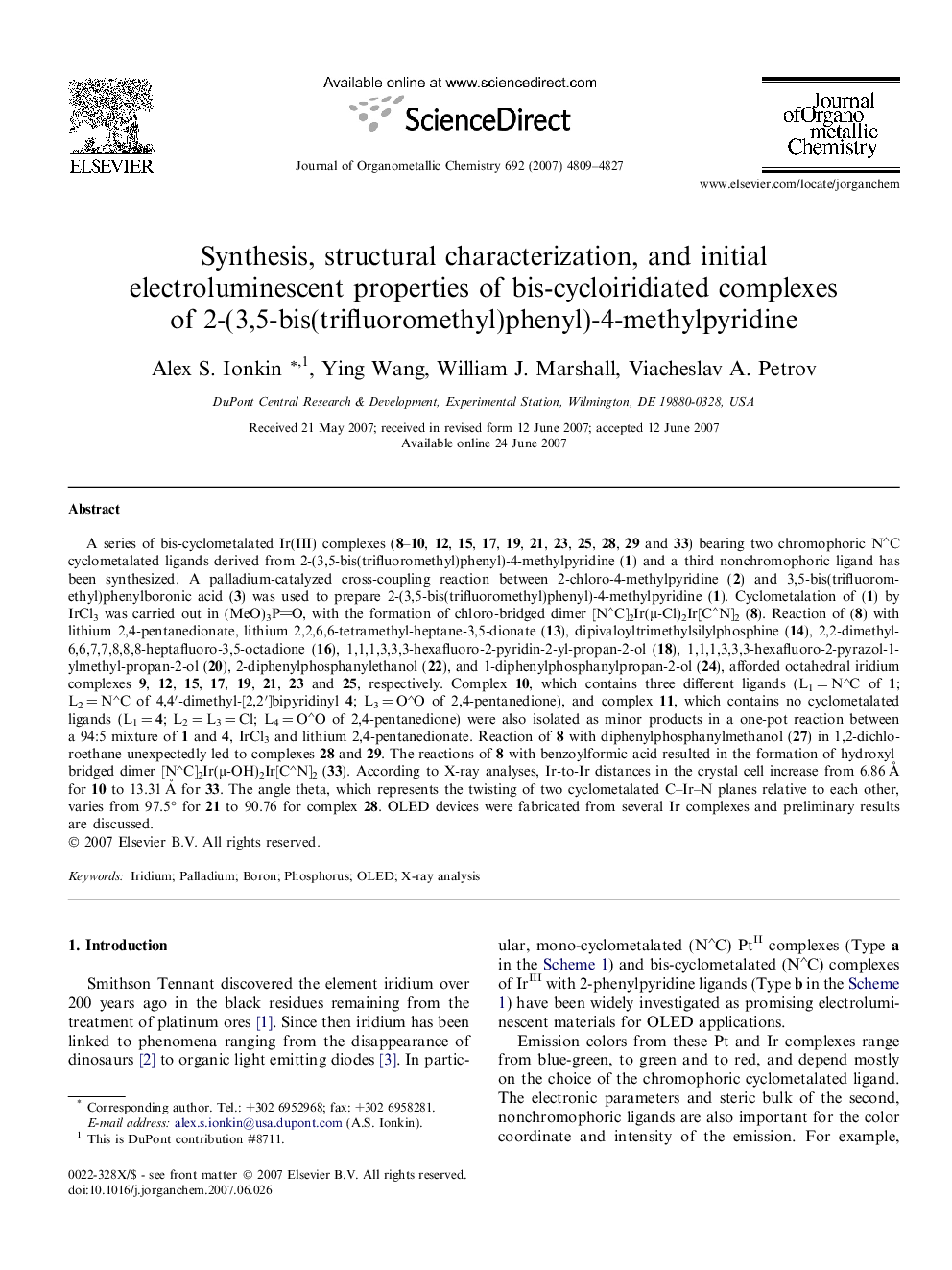| کد مقاله | کد نشریه | سال انتشار | مقاله انگلیسی | نسخه تمام متن |
|---|---|---|---|---|
| 1328152 | 977544 | 2007 | 19 صفحه PDF | دانلود رایگان |

A series of bis-cyclometalated Ir(III) complexes (8–10, 12, 15, 17, 19, 21, 23, 25, 28, 29 and 33) bearing two chromophoric N∧C cyclometalated ligands derived from 2-(3,5-bis(trifluoromethyl)phenyl)-4-methylpyridine (1) and a third nonchromophoric ligand has been synthesized. A palladium-catalyzed cross-coupling reaction between 2-chloro-4-methylpyridine (2) and 3,5-bis(trifluoromethyl)phenylboronic acid (3) was used to prepare 2-(3,5-bis(trifluoromethyl)phenyl)-4-methylpyridine (1). Cyclometalation of (1) by IrCl3 was carried out in (MeO)3PO, with the formation of chloro-bridged dimer [N∧C]2Ir(μ-Cl)2Ir[C∧N]2 (8). Reaction of (8) with lithium 2,4-pentanedionate, lithium 2,2,6,6-tetramethyl-heptane-3,5-dionate (13), dipivaloyltrimethylsilylphosphine (14), 2,2-dimethyl-6,6,7,7,8,8,8-heptafluoro-3,5-octadione (16), 1,1,1,3,3,3-hexafluoro-2-pyridin-2-yl-propan-2-ol (18), 1,1,1,3,3,3-hexafluoro-2-pyrazol-1-ylmethyl-propan-2-ol (20), 2-diphenylphosphanylethanol (22), and 1-diphenylphosphanylpropan-2-ol (24), afforded octahedral iridium complexes 9, 12, 15, 17, 19, 21, 23 and 25, respectively. Complex 10, which contains three different ligands (L1 = N∧C of 1; L2 = N∧C of 4,4′-dimethyl-[2,2′]bipyridinyl 4; L3 = O∧O of 2,4-pentanedione), and complex 11, which contains no cyclometalated ligands (L1 = 4; L2 = L3 = Cl; L4 = O∧O of 2,4-pentanedione) were also isolated as minor products in a one-pot reaction between a 94:5 mixture of 1 and 4, IrCl3 and lithium 2,4-pentanedionate. Reaction of 8 with diphenylphosphanylmethanol (27) in 1,2-dichloroethane unexpectedly led to complexes 28 and 29. The reactions of 8 with benzoylformic acid resulted in the formation of hydroxyl-bridged dimer [N∧C]2Ir(μ-OH)2Ir[C∧N]2 (33). According to X-ray analyses, Ir-to-Ir distances in the crystal cell increase from 6.86 Å for 10 to 13.31 Å for 33. The angle theta, which represents the twisting of two cyclometalated C–Ir–N planes relative to each other, varies from 97.5° for 21 to 90.76 for complex 28. OLED devices were fabricated from several Ir complexes and preliminary results are discussed.
A series of bis-cyclometalated Ir(III) complexes (8–10, 12, 15, 17, 19, 21, 23, 25, 28, 29 and 33) bearing 2-(3,5-bis(trifluoromethyl)phenyl)-4-methyl-pyridine (1) as the same N∧C cyclometalated ligand and the second nonchromophoric auxiliary ligands was synthesized. Preliminary OLED devices were fabricated from above complexes. The variation of the third ligand did not change the peak position of the spectra but has some effect on the spectral shape due to change in intermolecular packing.Figure optionsDownload as PowerPoint slide
Journal: Journal of Organometallic Chemistry - Volume 692, Issue 22, 15 October 2007, Pages 4809–4827